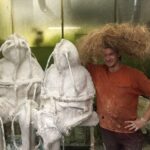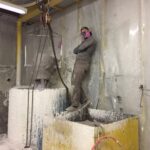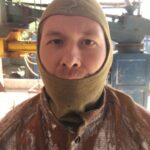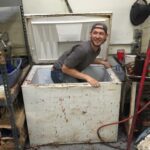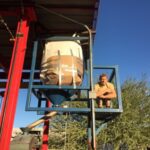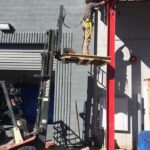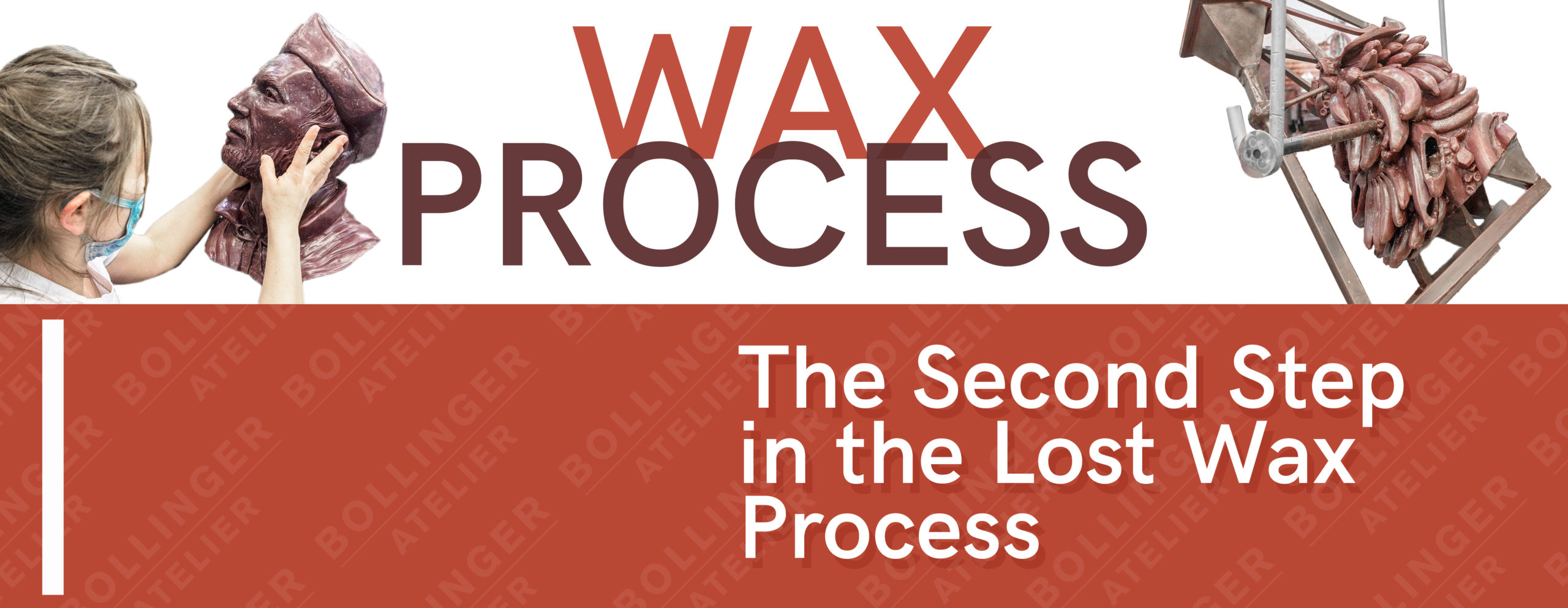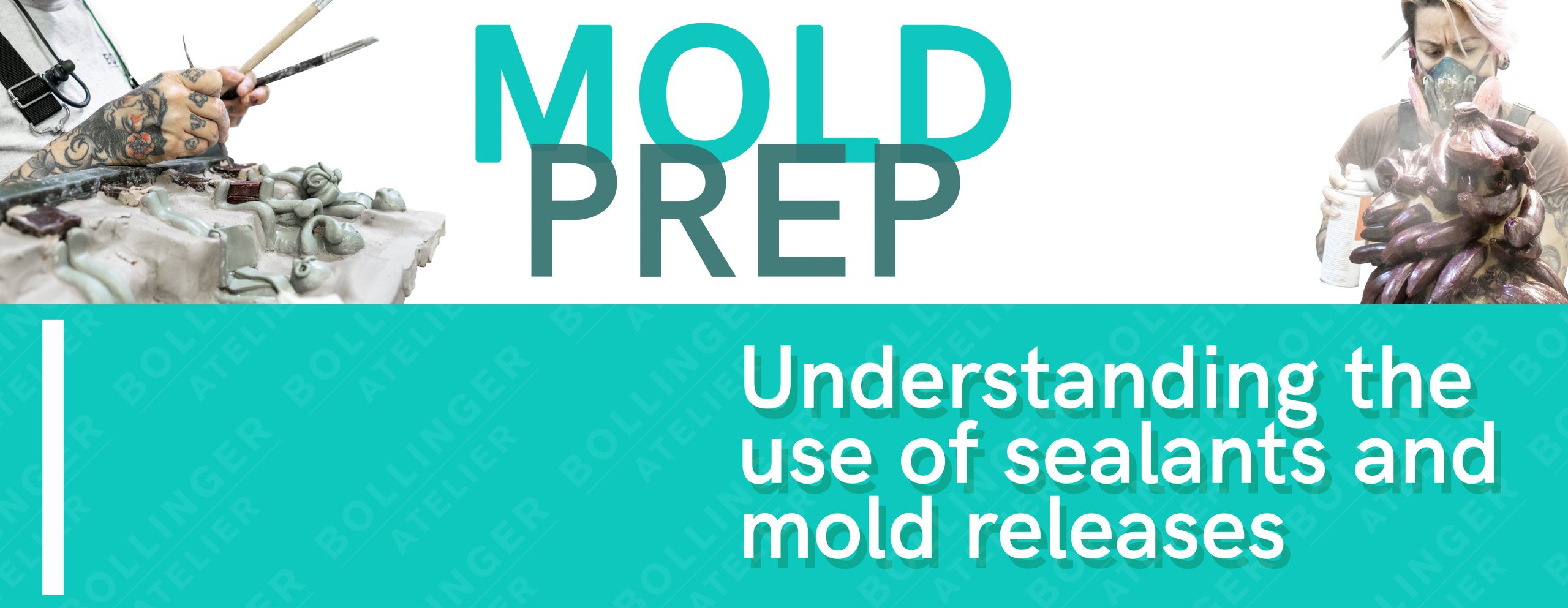The tables are officially turned today and the man who usually interviews has become the interviewee.
I am pleased to be with Daniel Mariotti today, exploring his work as an artisan here at Bollinger Atelier and his other life as an artist and craftsman.
Some history; Daniel arrived at BA in 2015 (the first time, more on that later). He had graduated from Arizona State University, Herberger School of Art in 2015 and was working in multiple fields when he was recommended to us by another talented Artisan. Daniel began assisting in several departments and quickly caught on to the Atelier game and found ways to use his data managing skills to speed up and track steps that had previously been analog. Simultaneously, Daniel was, and is, a performative artist/acrobat.
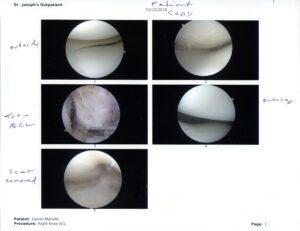
After a year or so, Daniel left the Atelier to travel the world and was exploring education and career options. Unfortunately, he suffered a significant knee injury while performing, a setback that led to surgery and a long recuperation. Lots of thinking and studio time ensued.
Eventually, we coaxed him back to BA to assist with social media and web development, including establishing this blog series, improving our web presence and setting up an in-house photo studio (among other steps in the future). He was so good at this we asked him to take on more responsibility in our digital technology department; taking on the task of learning to 3-D scan complex sculptures and operate our CNC system.
-Kim
(INTERVIEW)
BA: Tell me about your family tree, American? Italian?
Daniel: Mostly Polish actually. My mother is 100%; she came from there before meeting my dad and staying here. Dad is a mixed bag but 25% Polish, 50% Italian, and 25% Other.
BA: What do you do now at Bollinger Atelier? You seem to be all over the place!
Daniel: I do a lot of the Marketing communications for us; especially the content we put out. I am also our in-house photographer and Digital Specialist, where I get to help Jacob Sternberg (our General Manager) with all the digital projects that come through. But it’s not uncommon for all of us to cross-train and dip into other areas. I think that’s what makes us successful because we know the previous and next steps of the process and try to do things that will (hopefully) make the next step easier.

BA: What’s your art background? You seem to have several different focuses and a passion for detail.
Daniel: I have two BFA degrees from ASU. One is in photography, the other in printmaking. However, I first started at ASU in graphic design. I am constantly struggling with choosing a direction and am worried about not having enough time to do all the things. There are so many interesting outlets out in the world and I want to do them all, but know I can’t because apparently, we actually do need to sleep at some point. It’s only been recent that I’ve tried to narrow my focus to 1 or 4 things. I feel like I have a lot of holes in my work due to this and I guess narrowing my focus is me trying to fill those holes.
BA: You have the tidiest office space at BA. I don’t know if you want that to get out in public…can you explain that?
Daniel: Uh, I look at my office and think constantly it’s in disarray. But since I also use it as a mini photo studio, I know the importance of having things as clear and in order as possible to make sure all my shots are clean without any dirt or clutter. Plus, I like referencing past projects, so to do that easily I need to have a good system that I can easily access. I hate wasting 15 minutes on trying to find a thing when it could have been easily found in 30 sec. if it was just organized better.
BA: Did your work change while you were in school? And how has it changed since leaving?
Daniel: Yes. Very much so. College was the first time I really was immersed in the art world. So because of that, I was like a pinball machine looking at different artists and works and concepts, etc. I would take as many studio classes that used as many techniques as possible so that I had the knowledge. I guess for me, that period was all about technique and history. I never really pushed one style to mastery. And it was always about a singular piece. Post-school and really the past two years, I have been able to focus on making a series that is cohesive and that means something other than “look at what I can do”. And that has been the biggest breakthrough for me as an artist. Being able to tell a story through my work that opens up a conversation and is an opportunity to further dialogue. Also, never in a million years would I have expected to work in 3D. I was always a 2D artist. But I’m glad that’s changed. Sculpture has a presence to it that can’t be captured as easily as paper-work. It can greatly add to the narrative of the piece.
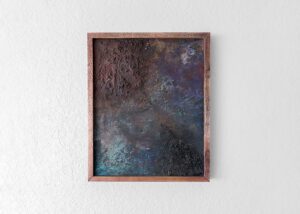
BA: Tell me a little about your own studio. What does it look like?
Daniel: My studio has been a constant struggle. I was grateful and really lucky to have been able to go to a school where I could use their studio during all times of the day. After school, I kind of floundered a bit and shifted focus into drawings and paintings because I could use the wall space of whatever apartment I was in at the time and work on it every day when I got home. And then I think it was 3 years ago I started converting my parents’ spare garage in East Mesa (they had a 3-car garage) into a studio space. Built a false wall to separate it from the cars, got flat files and an organizing unit along with basic tools etc. It’s cramped, so good organization is a must; but in the space, I’m able to do woodworking, minimal metalwork, screen printing, drawing and painting. I am very grateful to be able to do that, even with the 45 min. drive it takes to get there. It still needs tons of improvements for it to be truly functional, and right now it’s being used as a storage space again for my parents’ workout equipment.
BA: Also, now what do you do there, art-making wise?
Daniel: Recently I’ve been shifting my focus a lot. A year ago, I was making paintings and drawing and completing a photo project. I was showing a lot of that work in art shows everywhere and constantly applying to things. Now, I’ve kind of stepped back from the business side of art and am slowly chipping away at a new project that corresponds with my previous one. It’s more sculptural work. I’m also making small bronze work with the intent of eventually being able to create a public art piece (which as I’m editing this, yes I’m editing my own interview; goodbye 4th wall, I found out I get to create a piece for Scottsdale through the InFlux Cycle 9 program!).
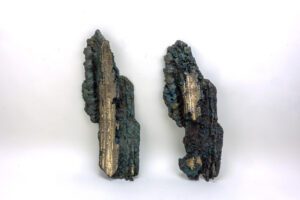
But most of my focus has been trying to learn music production so that I can record an album with Bradley Corso (our pour captain). We’ve been writing together for over a year now but neither of us knows how to self produce an album, and we can’t really afford to pay to get it done in a recording studio. So we’re taking our time and doing the slow and painful process of learning how to do all this. But I think it’s going to be a huge benefit because we’ll be able to control it and make it sound exactly how we want to. Also, it’s just the two of us. So it’s hard to hear and determine if, let’s say, what I wrote for bass fits well in the song when the second guitar is missing. Or if a piano part fits. So it’ll all come together in a recording and will be easier to determine and complete then. I hope.
BA: How long have you worked here at BA and what was your first day like?
Daniel: I wanna say I started in October of 2015. So it’ll be close to 4 years now. My first day I was very excited but nervous due to the fact that I knew absolutely nothing about the foundry. I had no idea what the steps where, what gating looked like in metal, what the front or back of a bronze looked like, etc (this is all mostly in reference to devest which is where I started out in). I didn’t know how to use the tools that we use. But I was lucky. Because my friend Will had worked there and was able to take me through the steps. Also, Campbell was extremely helpful in my learning. The first day, I started in the pit of course and almost immediately the air hammer stopped working. So I had to quickly learn how it worked and fix it. That was extremely exciting to me. The opportunity to quickly solve a problem like that even if it was simple was something I really liked. And so much of our work in every department is like that. We have a general base of guidelines we follow but every piece we touch is different and needs that problem-solving element.
Daniel his first year here at Bollinger. Photo courtesy of Will Jenkins.
BA: What was one of your favorite things to start learning here?
Daniel: Literally everything. I will say that I vocalize my distaste a lot, but that’s all a ruse. In reality, I love learning. But I will say learning digital is really appealing to me. It’s something I’ve always wanted to learn anyway, and this has been a nice opportunity to do so.
BA: What art do you most identify with?
Daniel: Anything that shows a piece of the artist in it. There’s one part of my brain that really appreciates form. A more graphic design approach to looking. So, some things I look at and am immediately drawn into because it’s just good design. But in the long run, I always appreciate the work more when it tries to tell something. I think that’s because of my photo background though. A lot of what we do and learn is sequencing. When work shows the history of a person or culture it’s beautiful.
BA: Do you have a different attitude about art by working here?
Daniel: Yes, and no. My approach hasn’t really changed. But my understanding of success has changed. So much of what art is, is in the marketing of the artist. The artist is a brand. And the success of the brand becomes the success of the artist. A lot less attention is about the art itself. But, that’s only one side of the coin. Because that’s in reference to monetary value. The other can be simply the ability to create. What circumstance can you give yourself to continue creating? Time plays a big factor in that. Coming out of school you may feel like it has to be immediate. You know? Like, I have to get into a show, I have to get a residency, etc. Like there’s a list you must check off. But that’s not necessarily the case. A project can take years to complete. And that is 100% ok and still successful. For me, that has been the biggest shift in perspective of myself. I’ve been trying to be ok with things taking time and not to be so immediately gratified. I think that’s also why I take on so many things. It distracts me from not being completed right away because I have to focus on constantly pushing forward.
BA: I’d like to know more about your days as a gymnast/acrobat/performative artist??
Daniel: Well, in college I fully immersed myself in parkour culture. It was just starting out in America and hadn’t blown up into what it is now. (Yes, I’ve seen the office scene. Just. Stop.) So, I would train practically every day for a minimum of 3 hours a day. That included learning tumbling, tricking, pole dancing, etc. to improve proprioception. Parkour feeds off of a lot of movement. In its essence, it’s learning how to control your body. There’s no end goal in it. Or at least there wasn’t. But anyway, through that I met a lot of people, I met my best friends. But also I had opportunities to get hired to do some ambient work through several companies. That just means getting dressed up as a character and creating unrehearsed movements in a certain perimeter that helps entertain and fill in blank spaces during events or parties. I was also lucky enough to play the role of a blissfully unaware janitor for a one night show titled “4: the Show” that was produced by my friend Lindsay Maxfield of Vertical Fix Productions. In one of the scenes, I … got it on with a broom. That’s all I have to say about that. My brother Chase, though, he’s the one living the dream. His full-time gig is performing, working for Cirque du Soleil, Catwall, and a plethora of other agencies. Currently he’s on tour in Canada for a new Cirque show called AXEL.
I guess I should also say that I have significantly done fewer things since my injury. I no longer have an ACL in my right knee, so any kind of turning or pivoting is out of the question, as well as any flips really. I’ve been taking ballet classes (with Michele Ceballos-Michot through Phoenix Center for the Arts) to strengthen it as well as trying to get into breakdancing just for myself. But often I only have time to just go to the gym.
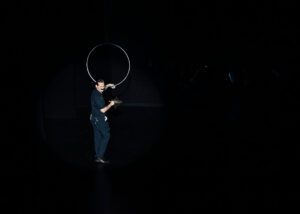
BA: What is your dream project?
Daniel: I have too many. But the one I want to see done 100% is this album I am creating with Brad.
BA: Did you grow up in AZ?
Daniel: Yes and no. I was born here. Went to school here, but the rest of the time till I was 17 I lived in Poland.
BA: What would you like to learn next?
Daniel: At Bollinger? I would like to get better at gating, and waxwork. Also, fabrication and patina. Personally? Music Production.
BA: What are some of your favorite “quirks” here (that you can talk about..)
Daniel: Every once in a while, Tom blasts music through the speakers. Once, he put Danny Boy on as I was making a mold. So that was a thing that happened.
BA: Do you think being an artisan is as valuable and rewarding as it is being the artist?
Daniel: Yes. But the two aren’t always separate. I think the most rewarding thing is being able to make work and not have to have others complete it for you, though I understand why that happens.
BA: Top 3 places in Phoenix to go to see great art…
There’s a place called “The Hive” in Phoenix that houses some great local shops as well as a Zine Distro called WIZD. I think it’s one of the places that is able to show and represent a huge variety of work from a huge number of artists. You can go in there and see guides for self-care, photo books (of which they carry mine called “Hello, Sunshine”), a zine on raptor Jesus, it goes on and on. But everything there is self-published, and hand made. And that makes it so special. It makes it genuine. Also, they host so many great events for creative; go follow them.

I like what Mesa Arts Center is doing. I feel like they are putting on interesting shows and have an amazing space to do so. They have great bands and performances going through there, as well as local shows. I think they’re doing a great job. I guess that’s in Mesa but whatever.
And finally, I’d say I try to follow what the ASU galleries do. It’s the best place to see what work and ideas new artists are developing and often the concepts and ideas they are working with are going to be less stagnant than what is typically shown in a place like the Phoenix Art Museum. But also, I’m an introvert and I don’t like going out to things and being in the presence of other people, so my thoughts on that could be completely off base.
BA: and…places we should avoid?
Daniel: Avoid any place on First Friday. Everything about that time gives me so much anxiety. Also avoid the Lavatory.
BA: Tell me about your travel to Germany? Where did you go?
Daniel: Went to Germany because I was intending on moving there for Grad School but also as a little vacation. We were mostly in Berlin but started our trip in France. Saw the things, ate the food. Went with friends as well so that was great especially since they very silently FRIGGIN’ GOT ENGAGED THERE. Anyway. It’s a beautiful place. Just not for me. But I also think I didn’t spend enough time to really get a good understanding of it, so that’s on me.
BA: Where will you travel next?
Daniel: Texas, for Thanksgiving. But also, I’m not sure. I still have this idea of living in Iceland for at least a year. And then going back to Poland for Grad School. But that’s future me’s problem.
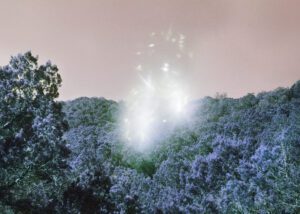
To see more of his work check out his website: www.danielmariotti.com
or follow him on Instagram: @dvmariot


